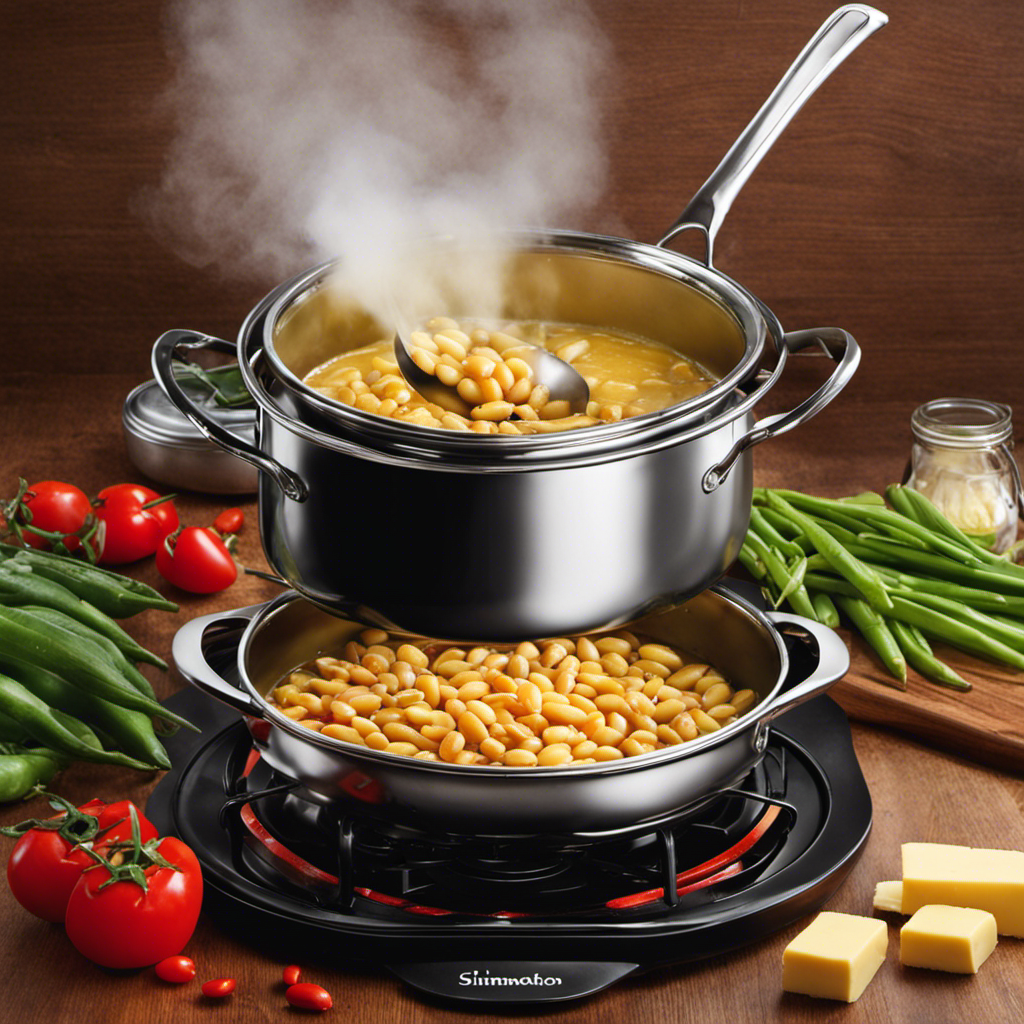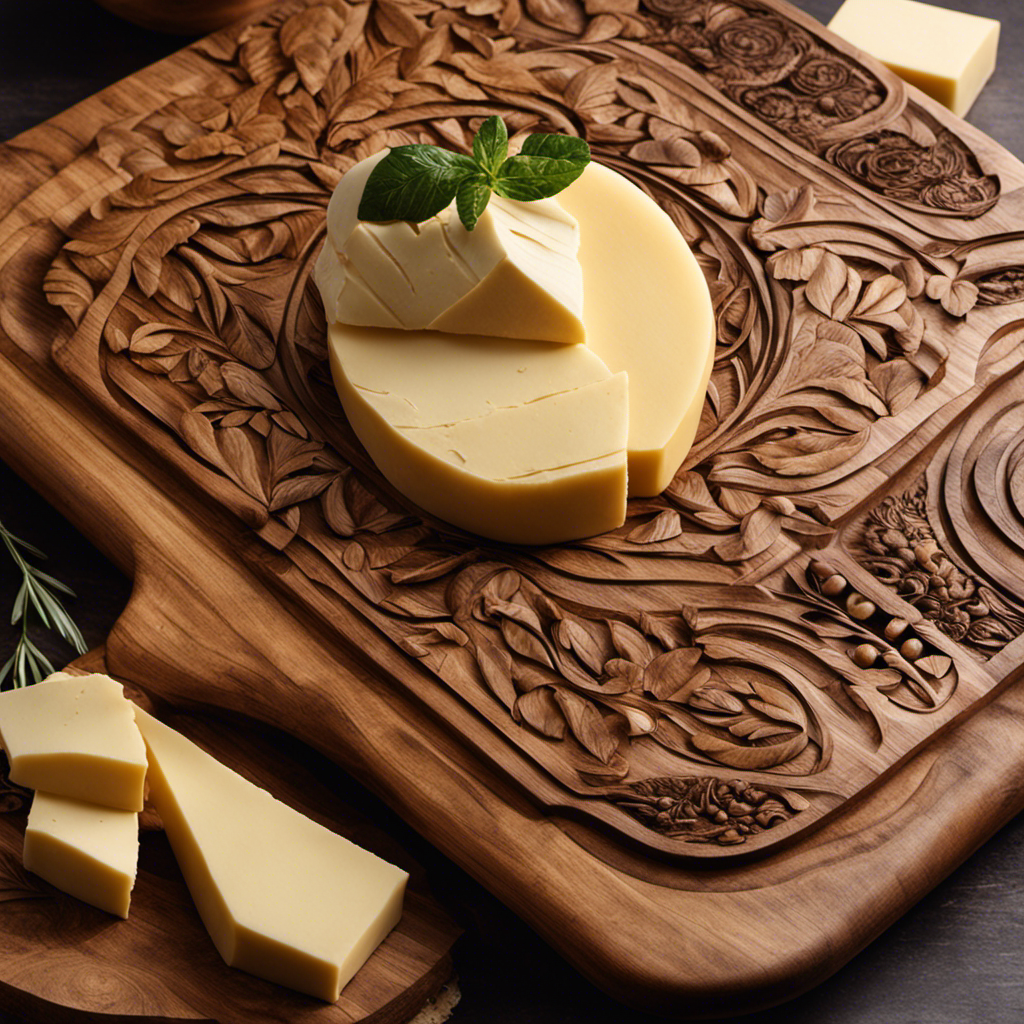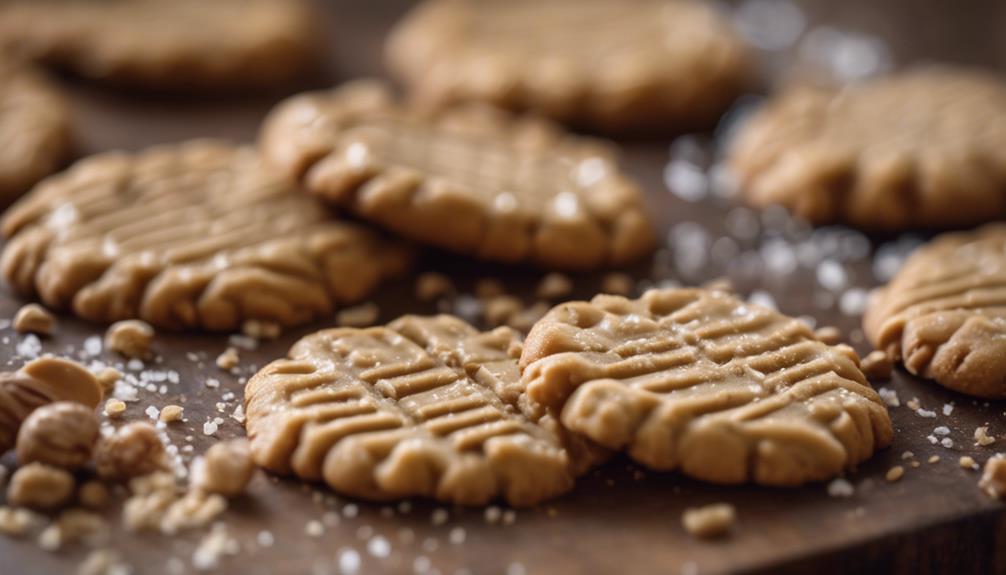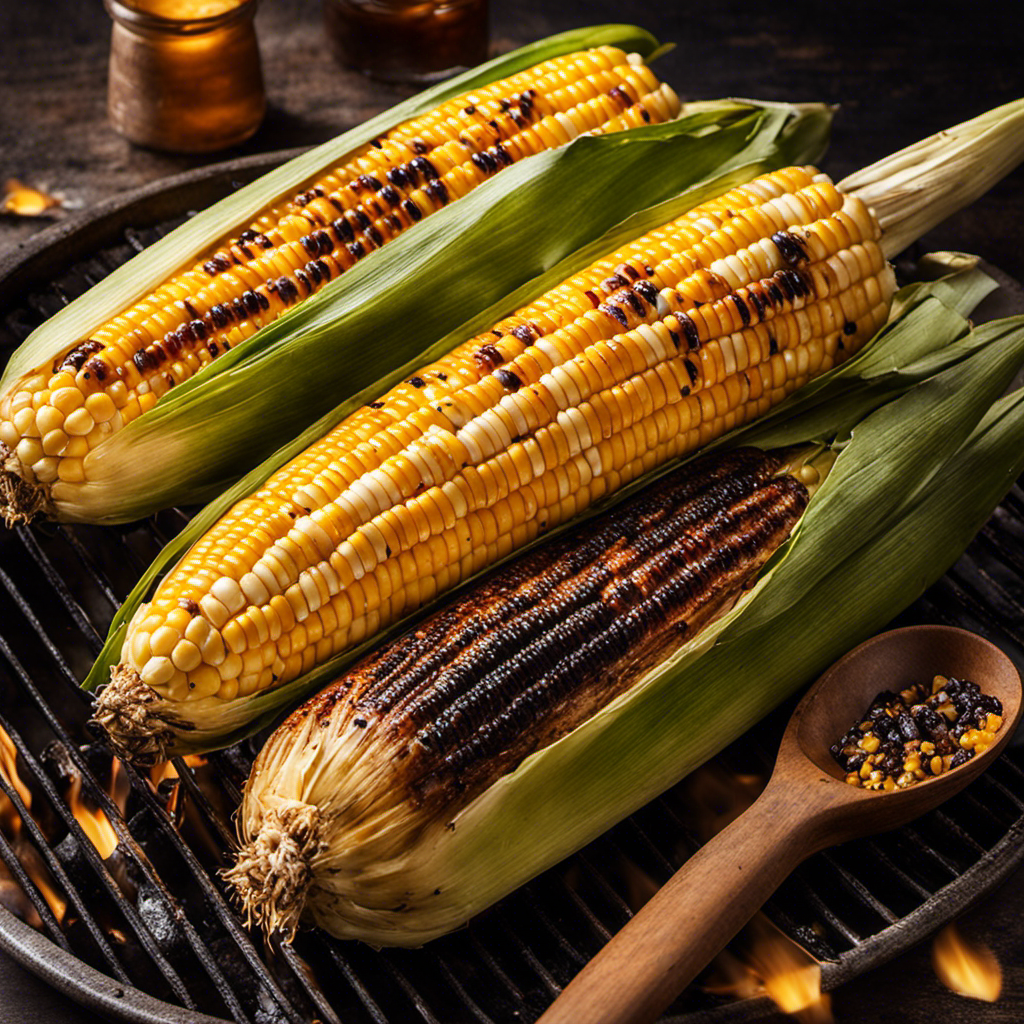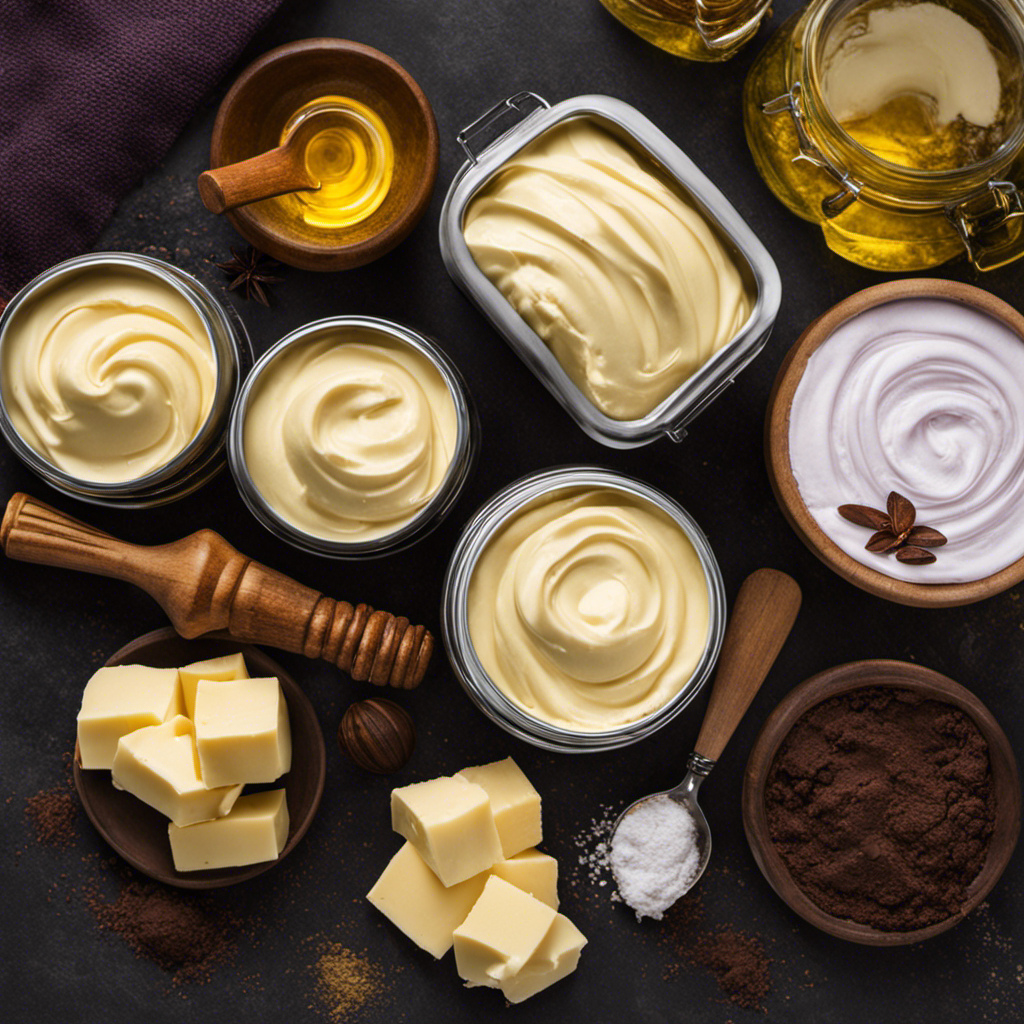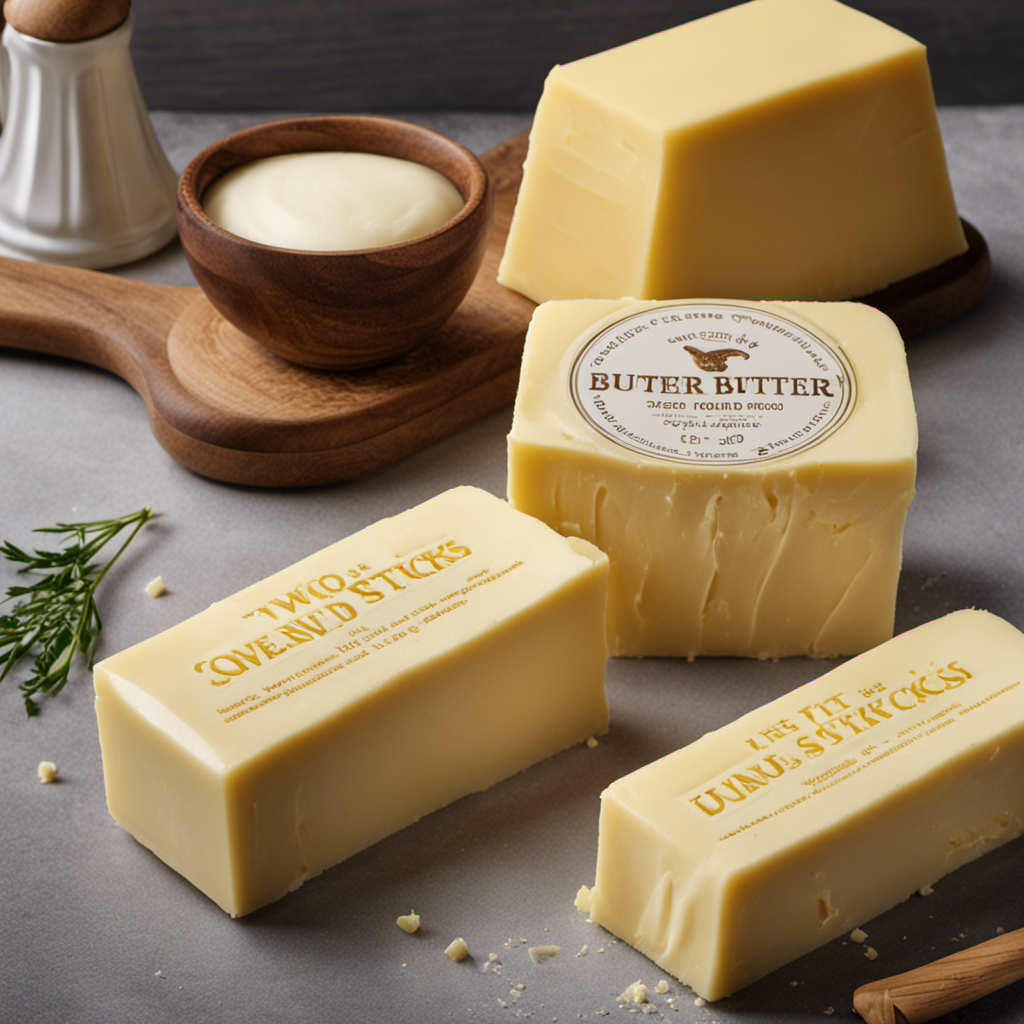I have a special tip that will take your canned butter beans to a higher level of yumminess.
In this guide, I’ll show you the precise steps to transform those humble beans into a mouthwatering dish that will leave everyone begging for more.
From choosing the perfect beans to adding flavorful seasonings, I’ll guide you through every step of the process.
Get ready to impress your taste buds with my knowledge and expertise in cooking butter beans in a can.
Key Takeaways
- Choose high-quality and fresh butter beans without any discoloration or blemishes.
- Soak canned butter beans in water for about 2 hours to soften them and reduce cooking time.
- Experiment with different seasonings and flavorings to enhance the taste of butter beans.
- Use various cooking methods such as stove cooking, microwave cooking, slow cooker, pressure cooking, or baking in the oven to prepare butter beans.
Choosing the Right Butter Beans
When choosing the right butter beans, it’s important to consider the quality and freshness of the beans. Butter beans, also known as lima beans, are a nutritious and versatile legume that can be used in a variety of dishes.
To ensure you’re getting the best beans, look for ones that are plump, firm, and free from any discoloration or blemishes. When it comes to cooking techniques, butter beans can be boiled, steamed, or even roasted to bring out their unique flavor and texture.
These beans are not only delicious but also packed with health benefits. They are a good source of protein, fiber, and essential vitamins and minerals, making them a great addition to a balanced diet.
Preparing the Butter Beans for Cooking
Before starting the preparation, it’s important to ensure that the can of butter beans is thoroughly rinsed. This removes any excess salt or preservatives and helps to improve the overall taste of the dish.
After rinsing, I like to soak the canned butter beans in water for about 2 hours. Soaking helps to soften the beans and reduce their cooking time. The water also helps to remove any remaining impurities or starch from the beans.
Once the soaking time is complete, I drain the water and the beans are ready to be cooked.
Seasoning and Flavoring Options
To enhance the taste of the dish, you can experiment with different seasonings and flavorings.
When it comes to flavoring techniques for butter beans, the options are endless. One creative seasoning option is to add a splash of soy sauce for a savory and umami-rich flavor.
Another option is to sprinkle some smoked paprika for a smoky and slightly spicy kick.
For a fresh and zesty twist, you can squeeze some lemon juice over the beans or add a sprinkle of lemon zest.
If you prefer a Mediterranean flavor, try adding a pinch of dried oregano and a drizzle of olive oil.
Don’t be afraid to get creative and mix and match different seasonings to find your perfect flavor combination.
Cooking Butter Beans on the Stove
When it comes to cooking butter beans, there are a few key points to consider.
First, the stove vs. microwave cooking method can make a significant difference in the final result. While the stove allows for better control over the cooking process and can result in a more evenly cooked dish, the microwave offers convenience and faster cooking time.
Additionally, the choice of seasoning and flavoring options can greatly enhance the taste of butter beans. From traditional herbs and spices to experimenting with different sauces and condiments, there are endless possibilities to explore.
Lastly, cooking time and temperature are crucial factors to ensure perfectly cooked butter beans. Knowing the optimal cooking time and temperature will help you achieve the desired texture and flavor, whether you prefer your beans soft and creamy or slightly firm.
Stove Vs. Microwave Cooking
If you’re in a hurry, you can quickly cook butter beans in a can using the microwave. However, there are some differences between microwave cooking and oven cooking that are important to consider.
Microwave cooking is known for its speed and convenience. It uses electromagnetic waves to heat the food from the inside out, allowing for quick cooking times. On the other hand, oven cooking relies on radiant heat from the top and bottom elements to cook the food evenly. This method is slower but can result in a more flavorful and evenly cooked dish.
One of the benefits of slow cooking is that it allows the flavors to develop and meld together over time. This is especially true for dishes like butter beans, where the longer cooking time allows the flavors to deepen and intensify. Slow cooking also allows for the breakdown of tough fibers in the beans, resulting in a tender and creamy texture.
Seasoning and Flavoring Options
Seasoning and flavoring options can greatly enhance the taste of your dish. When it comes to butter beans, there are numerous ways to add delicious flavors. Here are some butter bean seasoning ideas and flavoring methods to elevate your dish:
-
Spices: Sprinkle some paprika, garlic powder, or cayenne pepper for a touch of heat and depth of flavor.
-
Herbs: Fresh or dried herbs like thyme, rosemary, or parsley can add an aromatic and earthy taste.
-
Citrus: Squeeze some lemon or lime juice over the beans to brighten the flavors and add a tangy kick.
These seasoning options can transform your butter beans into a mouthwatering dish. Experiment with different combinations and find your favorite flavor profile. Whether you prefer a spicy kick or a refreshing citrus twist, these ideas will take your butter beans to the next level.
Cooking Time and Temperature
To achieve the desired texture and flavor, it’s important to adjust the cooking time and temperature accordingly.
When it comes to cooking butter beans, there are a few key points to keep in mind. First, choose a cooking technique that suits your preferences and available equipment.
Boiling butter beans is a quick and easy method, but it can result in a softer texture. On the other hand, simmering the beans over low heat for a longer period of time can yield a creamier consistency.
Additionally, consider the nutritional benefits of butter beans. They are a good source of protein, fiber, and vitamins, making them a healthy addition to your meals.
Now, let’s explore using a slow cooker for butter beans and how it can enhance the cooking process.
Using a Slow Cooker for Butter Beans
Using a slow cooker to cook butter beans offers several benefits.
Firstly, it allows for hands-off cooking, as you can simply set it and forget it.
Secondly, slow cooking helps to tenderize the beans and infuse them with flavor.
Lastly, the slow cooker’s low and slow cooking method allows for the development of deep and rich flavors.
When it comes to cooking time recommendations, it is generally recommended to cook butter beans on low heat for 6-8 hours or on high heat for 3-4 hours until they are tender.
As for the best flavor combinations, popular options include adding smoked ham hocks, onions, garlic, and herbs like thyme and bay leaves for a savory and aromatic dish.
Slow Cooker Benefits
If you’re short on time, a slow cooker can be a convenient way to cook butter beans in a can. Slow cooker recipes offer numerous benefits, making them a popular choice for busy individuals. Here are some reasons why slow cooking can be advantageous:
- Retains Nutritional Value: Slow cooking preserves the nutrients in the food, ensuring that you get a healthy and nourishing meal.
- Enhances Flavors: The slow and gentle cooking process allows the flavors to meld together, resulting in a more delicious and flavorful dish.
- Saves Time and Effort: Once you set up the ingredients in the slow cooker, you can simply leave it to do its magic while you attend to other tasks.
With these benefits in mind, it’s time to explore the recommended cooking times for butter beans in a can.
Cooking Time Recommendations
Once you’ve gathered all the necessary ingredients, simply set the timer and let the slow cooker work its magic for the recommended cooking time.
Slow cooking is one of the easiest and most convenient cooking methods for butter beans in a can. The slow cooker allows the beans to cook slowly and gently, resulting in tender and flavorful beans.
The recommended cooking time for butter beans in a can is typically around 4 to 6 hours on low heat. During this time, the beans will absorb the flavors of any seasonings or spices you add to the cooker.
You can use the cooked butter beans in a variety of recipes, such as soups, stews, salads, or even as a side dish. The slow cooker method is a versatile and effortless way to prepare delicious butter beans.
Best Flavor Combinations?
When it comes to the best flavor combinations for butter beans, the options are endless. Here are some serving suggestions and creative butter bean dishes that will take your meal to the next level:
-
Butter beans with garlic and herbs: Sauté minced garlic in olive oil, then add cooked butter beans and toss with fresh herbs like thyme, rosemary, and parsley. This aromatic dish is perfect as a side or a main course.
-
Butter bean and vegetable stir-fry: Sauté a medley of colorful vegetables like bell peppers, zucchini, and carrots, then add cooked butter beans for a protein-packed twist. Season with soy sauce and a dash of sesame oil for an Asian-inspired flavor.
-
Butter bean salad with feta and cherry tomatoes: Toss cooked butter beans with crumbled feta cheese, halved cherry tomatoes, chopped cucumbers, and a drizzle of balsamic vinaigrette. This refreshing salad is great for a light lunch or a side dish at a barbecue.
With these serving suggestions and creative butter bean dishes, you’ll never run out of delicious ways to enjoy this versatile legume.
Now, let’s move on to the next section and discover how to pressure cook butter beans.
Pressure Cooking Butter Beans
Pressure cooking butter beans is a quick and efficient way to soften them for delicious recipes. The benefits of pressure cooking include reduced cooking time and increased retention of nutrients. Compared to other cooking methods like boiling or soaking overnight, pressure cooking allows the beans to cook in a fraction of the time. The high pressure and heat help to break down the tough fibers of the beans, resulting in a creamy and tender texture. It’s a convenient alternative for those who don’t have the time to wait for traditional cooking methods.
However, if you prefer a different texture or want to try a different flavor profile, baking butter beans in the oven is another great option.
Baking Butter Beans in the Oven
Baking butter beans in the oven gives them a crispy texture and allows for a different flavor profile. It’s a great way to elevate this humble legume and create delicious dishes like butter bean casserole or butter bean soup.
Here’s how to do it:
- Preheat the oven to 400°F.
- Drain and rinse a can of butter beans.
- Spread the beans on a baking sheet in a single layer.
- Drizzle with olive oil and sprinkle with salt, pepper, and any desired seasonings.
- Toss the beans to coat them evenly.
- Bake for 20-25 minutes, or until the beans are golden brown and crispy.
- Remove from the oven and let them cool slightly before using them in your favorite recipes.
Baking butter beans in the oven adds a delightful crunch to their creamy texture, making them perfect for casseroles or soups. Give it a try and enjoy the new dimension of flavor it brings to your dishes.
Butter Bean Recipes and Variations
Now that we’ve explored baking butter beans in the oven, let’s move on to some delicious butter bean recipes and variations. One popular option is a refreshing butter bean salad, which combines the creamy texture of the beans with crisp vegetables and a tangy dressing. It’s a perfect side dish for a summer barbecue or a light lunch.
Another tasty option is butter bean soup, a comforting and hearty dish that is perfect for colder days. This soup typically includes a flavorful broth, tender butter beans, and a medley of vegetables and herbs. It can be customized with additional ingredients like sausage or bacon for added richness and depth of flavor.
To give you a better idea of the possibilities, here’s a table showcasing some variations of butter bean recipes:
| Butter Bean Recipe | Description | Ingredients |
|---|---|---|
| Butter Bean Salad | Refreshing salad with butter beans and vegetables | Butter beans, veggies, dressing |
| Butter Bean Soup | Hearty soup with butter beans and vegetables | Butter beans, broth, veggies |
| Butter Bean Casserole | Baked dish with butter beans and other ingredients | Butter beans, cheese, spices |
With these recipes and variations, you’ll be able to enjoy the versatility and deliciousness of butter beans in various ways.
Storing and Reheating Butter Beans
To keep them fresh for longer, it’s best to store cooked butter beans in an airtight container in the refrigerator. Here are some tips on storing and reheating butter beans:
-
Storing Methods:
-
Transfer the cooked butter beans to a clean, airtight container.
-
Make sure the container is sealed tightly to prevent any air or moisture from entering.
-
Place the container in the refrigerator, where the beans can stay fresh for up to 4 days.
-
Reheating Tips:
-
To reheat butter beans, simply take out the desired portion from the refrigerator.
-
You can choose to microwave them by placing them in a microwave-safe dish and heating them on high for a few minutes, stirring occasionally.
-
Alternatively, you can reheat them on the stovetop by adding a little water or broth to a saucepan and simmering the beans until heated through.
Frequently Asked Questions
Can I Cook Butter Beans Directly From the Can Without Any Additional Preparation?
Yes, you can cook butter beans directly from the can without any additional preparation. However, for enhanced flavor, you may want to sauté some onions and garlic before adding the beans. Butter beans are a nutritious source of protein and fiber.
How Long Do Butter Beans Typically Need to Cook on the Stove Before They Are Tender?
To cook butter beans on the stove, they usually need about 30-40 minutes until they’re tender. Here are some tips: soak them overnight, add salt for flavor, and simmer gently to prevent them from getting mushy.
Can I Freeze Leftover Cooked Butter Beans for Later Use?
Yes, you can freeze leftover cooked butter beans for later use. They can be stored in an airtight container or freezer bag for up to 3 months. They are great for soups, stews, or as a side dish.
Are There Any Specific Herbs or Spices That Pair Well With Butter Beans?
There are several herbs and spices that pair well with butter beans, such as thyme, rosemary, garlic, and paprika. They can enhance the flavor of the beans and add depth to dishes like soups, stews, and salads.
Can I Substitute Canned Butter Beans With Dried Beans in Recipes?
I find substituting canned butter beans with dried beans in recipes to be a viable option. However, it is important to properly rehydrate the dried beans before using them to ensure optimal texture and taste.
Conclusion
In conclusion, cooking butter beans in a can is a convenient and delicious option for any meal. By choosing the right beans and preparing them properly, you can create a flavorful dish that will satisfy your taste buds.
Whether you prefer cooking on the stove, using a slow cooker, pressure cooking, or baking in the oven, there are various methods to suit your needs. Don’t forget to explore different seasoning and flavoring options to enhance the taste.
So go ahead and give it a try, cooking butter beans in a can is like unlocking a treasure trove of creamy goodness in every bite.
